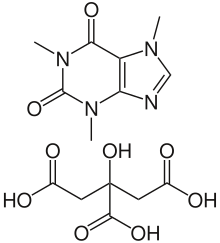Caffeine citrate
 | |
| Clinical data | |
|---|---|
| Trade names | Cafcit, Gencebok, Cafnea, others |
| AHFS/Drugs.com | Monograph |
| License data | |
| Routes of administration | By mouth, intravenous (IV) |
| ATC code | |
| Legal status | |
| Legal status | |
| Identifiers | |
| |
| CAS Number | |
| PubChem CID | |
| ChemSpider | |
| UNII | |
| KEGG | |
| ChEMBL | |
| CompTox Dashboard (EPA) | |
| ECHA InfoCard | 100.125.472 |
| Chemical and physical data | |
| Formula | C14H18N4O9 |
| Molar mass | 386.317 g·mol−1 |
| 3D model (JSmol) | |
| |
| |
| (verify) | |
Caffeine citrate, sold under the brand name Cafcit among others, is a medication used to treat a lack of breathing in premature babies.[5] Specifically it is given to babies who are born at less than 35 weeks or weigh less than 2 kilograms (4.4 lb) once other causes are ruled out.[6] It is given by mouth or slow injection into a vein.[5]
Side effects can include problems feeding, increased heart rate, low blood sugar, necrotizing enterocolitis, and kidney problems.[5][6] Testing blood caffeine levels is occasionally recommended.[5] Although it is often referred to as a citric acid salt of caffeine,[7] as implied by its name, caffeine citrate in fact consists of cocrystals of the two components.[8] Caffeine citrate is in the xanthine family of medication.[6] It works by stimulating the respiratory centers in the brain.[5]
Caffeine was discovered in 1819.[9] It is on the World Health Organization's List of Essential Medicines.[10] The intravenous form may also be taken by mouth.[11]
In June 2020, the Committee for Medicinal Products for Human Use (CHMP) of the European Medicines Agency (EMA) recommended the approval of Gencebok.[12] It was approved for use in the European Union in August 2020.[3]
Medical uses
[edit]Caffeine citrate is generally the preferred treatment for apnea of prematurity for infants born 28 to 32 weeks or earlier than 28 weeks.[6][13] It has fewer side effects as compared to theophylline.[6]
Caffeine improves airway function in asthma, increasing forced expiratory volume (FEV1) by 5% to 18%, with this effect lasting for up to four hours.[14]
Mechanism
[edit]In method of action, the preparation is identical to that of caffeine base as the citrate counter ion dissociates in water. Doses of caffeine citrate, due to the added weight of the citrate moiety, are understandably higher than with caffeine base, i.e., it takes a larger dose to get the same amount of caffeine.[11] The ratio of therapeutic doses of caffeine base to its citrate salt is typically 1:2.[11] Dosing should therefore be clearly distinguished.[11]
Manufacture
[edit]The drug is prepared by combining anhydrous caffeine with citric acid monohydrate and sodium citrate dihydrate. Caffeine citrate cocrystals can take on at least two anhydrous polymorphs.[8]
References
[edit]- ^ "Regulatory Decision Summary - Peyona". Health Canada. 23 October 2014. Retrieved 5 June 2022.
- ^ "Cafcit- caffeine citrate injection". DailyMed. 3 January 2020. Retrieved 27 August 2020.
- ^ a b "Gencebok EPAR". European Medicines Agency (EMA). 19 June 2020. Retrieved 27 August 2020.
- ^ "Gencebok Product information". Union Register of medicinal products. Retrieved 3 March 2023.
- ^ a b c d e "Caffeine; Caffeine and Sodium Benzoate Injection; Caffeine Citrate". The American Society of Health-System Pharmacists. Archived from the original on 16 July 2017. Retrieved 8 December 2016.
- ^ a b c d e World Health Organization (2009). Stuart MC, Kouimtzi M, Hill SR (eds.). WHO Model Formulary 2008. World Health Organization. p. 485. hdl:10665/44053. ISBN 9789241547659.
- ^ Donn SM, Sinha SK (2012). Manual of Neonatal Respiratory Care. Springer Science & Business Media. p. 457. ISBN 9781461421559. Archived from the original on 30 December 2016.
- ^ a b Smit JP, Hagen EJ (1 March 2015). "Polymorphism in Caffeine Citric Acid Cocrystals". Journal of Chemical Crystallography. 45 (3): 128–133. doi:10.1007/s10870-015-0573-3. ISSN 1572-8854. S2CID 96712417.
- ^ Brown N (2015). In Silico Medicinal Chemistry: Computational Methods to Support Drug Design. Royal Society of Chemistry. p. 20. ISBN 9781782621638. Archived from the original on 29 December 2016.
- ^ World Health Organization (2019). World Health Organization model list of essential medicines: 21st list 2019. Geneva: World Health Organization. hdl:10665/325771. WHO/MVP/EMP/IAU/2019.06. License: CC BY-NC-SA 3.0 IGO.
- ^ a b c d Ainsworth SB (2014). Neonatal Formulary: Drug Use in Pregnancy and the First Year of Life (7 ed.). John Wiley & Sons. p. 120. ISBN 9781118819517. Archived from the original on 30 December 2016.
- ^ "Gencebok: Pending EC decision". European Medicines Agency (EMA). 25 June 2020. Archived from the original on 27 June 2020. Retrieved 26 June 2020.
- ^ "NIH-funded research leads to pediatric labeling updates for doxycycline, clindamycin and caffeine citrate". National Institutes of Health (NIH). 2 April 2020. Retrieved 27 July 2022.
- ^ Welsh EJ, Bara A, Barley E, Cates CJ (January 2010). "Caffeine for asthma". The Cochrane Database of Systematic Reviews. 2010 (1): CD001112. doi:10.1002/14651858.CD001112.pub2. PMC 7053252. PMID 20091514.
External links
[edit]- "Caffeine Citrate (CUI C0054436)". NCI Metathesaurus.
